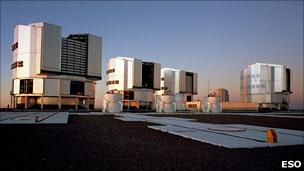Wreckage is from 'pristine star'
- Published

The observations required the use of world class telescopes such as the VLT in Chile
UK and US scientists have found the remnants of a star that exploded more than 13 billion years ago.
It would most probably have been one of the very first stars to shine in the Universe, they say.
All that is left of this pioneer is the gas cloud it threw out into space when it blew itself apart.
It was identified when its contents were illuminated by the brilliant light coming from the surroundings of a distant black hole.
The cloud's atoms occur in abundances that are quite unlike that found in the nearby cosmos today and are more what one would expect from stars that were originally made only of hydrogen and helium.
The research required the observations of two of the world's most powerful telescopes - the Keck facility in Hawaii and the Very Large Telescope in Chile.
It has been written up, external in the Monthly Notices of the Royal Astronomical Society.
'Holy Grail'
The study is said to provide fresh insight on key events in the earliest stages of the Universe, in particular it offers some new details on the endings of the so-called "Dark Ages", the period before the first stars formed.
"It's a period we know very little about, but the Universe at that time was a rather boring place, just filled with hydrogen and helium gas and not much else; there was no light - that's why it's called the Dark Ages," explained Professor Max Pettini at Cambridge's Institute of Astronomy, UK.
"And then somehow from that initial state it changed into this wonderful mix of stars and planets and galaxies that we see around us today."
Working on the Keck and VLT, Pettini's team probed the composition of distant clouds of gas known as "damped Lyman alpha systems". They did this using the light provided by quasars, extremely luminous galaxies whose brilliance is powered by a mighty black hole at their core.
The investigation identified one particular DLA that had a unique chemical signature - one where the ratio of carbon to iron atoms was 35 times greater than what can be measured in the Sun. It enabled the group to infer that the gas was released by a star 25 times more massive than our star and which originally consisted of only hydrogen and helium - exactly the type of star expected to have ended the Dark Ages.
"The first stars have been a bit like the Holy Grail for astronomers," said Professor Pettini, who led the research with PhD student Ryan Cooke.
"We think that they all lived very short and furious lives. They are all dead now, and there is no way for us even with the most powerful telescopes to observe them directly. So, what we have found is the remnants of one of these first stars to form in the Universe, and the elements carbon, oxygen and iron and pristine gas in a mix that has never been seen before."
Next generation
The results of the study, conducted with partners at the California Institute of Technology (Caltech), will feed into the theoretical framework scientists are building to describe this early epoch.
Scientists believe the very first stars to shine in the Universe were hot giants that fundamentally changed the cosmic environment.

Future telescope technology will have the power to probe this early epoch more easily
Not only did they seed the cosmos with the heavier elements needed to make planets, but their intense ultraviolet radiation also "fried" the neutral gas around them. The consequences of this latter process are evident even today in the diffuse plasma that fills the space between the galaxies.
"This was only a first step; it was like finding some fossil," Professor Pettini told the BBC.
"Now that we have discovered how to find such fossil evidence, we are much better placed for finding other examples of these particular clouds in the distant Universe that hold the special clues; and then progress from there and really breakthrough what has been called the last frontier in observational astronomy."
Finding out any information about this early period, just a few hundred million years after the Big Bang, is a tour de force because it takes existing technology such as the Keck and VLT right to the limits of their capability.
Only with the next generation of observatories - super telescopes with mirrors tens of metres in diameter - can scientists hope to probe more widely into the circumstances that ended the Dark Ages.
The European Southern Observatory Organisation, which runs the VLT, plans to build a telescope with a 42m-wide mirror, and Caltech is involved in a project to build one with a mirror that is 30m in diameter.
- Published20 October 2010